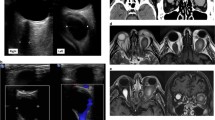Abstract
LL is a 25-year-old woman who presented with the sudden onset of pain around her right eye and noted a “blood blister” under the upper eyelid with some lid ecchymosis. Echography revealed widening, echolucency, and low reflectivity of the subperiosteal space (Fig. 1). She was treated with cold compresses and the discontinuation of aspirin products. Follow-up ultrasound demonstrated a multicystic lesion consistent with an orbital lymphangioma or orbital varix. She had a history of a similar lesion under her tongue.
You have full access to this open access chapter, Download chapter PDF
Similar content being viewed by others
Keywords
These keywords were added by machine and not by the authors. This process is experimental and the keywords may be updated as the learning algorithm improves.
LL is a 25-year-old woman who presented with the sudden onset of pain around her right eye and noted a “blood blister” under the upper eyelid with some lid ecchymosis. Echography revealed widening, echolucency, and low reflectivity of the subperiosteal space (Fig. 1). She was treated with cold compresses and the discontinuation of aspirin products. Follow-up ultrasound demonstrated a multicystic lesion consistent with an orbital lymphangioma or orbital varix. She had a history of a similar lesion under her tongue.
Less common causes of pain around the eye and orbit include metastatic tumors from distant sites or secondary invasion from contiguous areas, such as the paranasal sinuses. This pain is especially severe in rapidly expanding lesions that often induce an inflammatory reaction, in cases of perineural invasion and also in those with bone destruction.
Metastatic invasion of the orbit may give a V pattern of reflectivity on the A-scan. This appearance is due to the manner of infiltration of the orbital tissue by the malignant cells. The area of invasion becomes relatively low reflective because of the dense homogeneity of the neoplastic cell population with a relative paucity of interfaces between different tissue types. Adjacent to the central concentration of cells are areas of higher reflectivity and heterogeneity as malignant cells less densely infiltrate normal orbital tissue. The A-scan spikes in such an area are reflected more strongly by the multiple tissue interfaces. Metastatic tumors in the orbit are generally quite firm to compression when they are imaged on the paraocular examination.
Author information
Authors and Affiliations
Rights and permissions
Copyright information
© 2014 Springer Science+Business Media New York
About this chapter
Cite this chapter
Harrie, R.P., Kendall, C.J. (2014). Case Study 59 Bleed into Lymphangioma. In: Clinical Ophthalmic Echography. Springer, New York, NY. https://doi.org/10.1007/978-1-4614-7082-3_59
Download citation
DOI: https://doi.org/10.1007/978-1-4614-7082-3_59
Published:
Publisher Name: Springer, New York, NY
Print ISBN: 978-1-4614-7081-6
Online ISBN: 978-1-4614-7082-3
eBook Packages: MedicineMedicine (R0)





